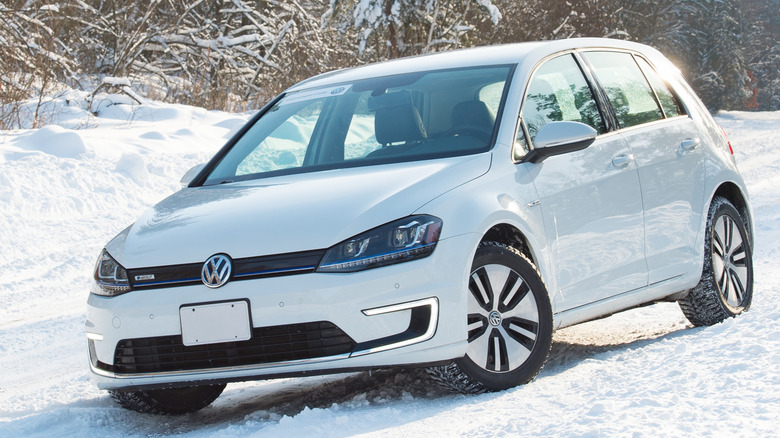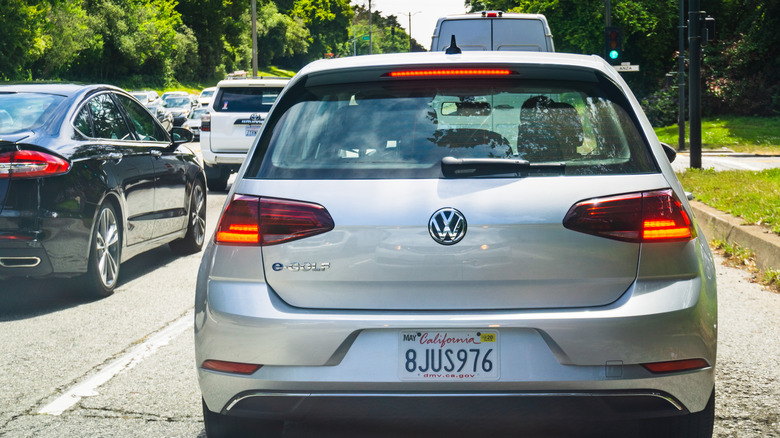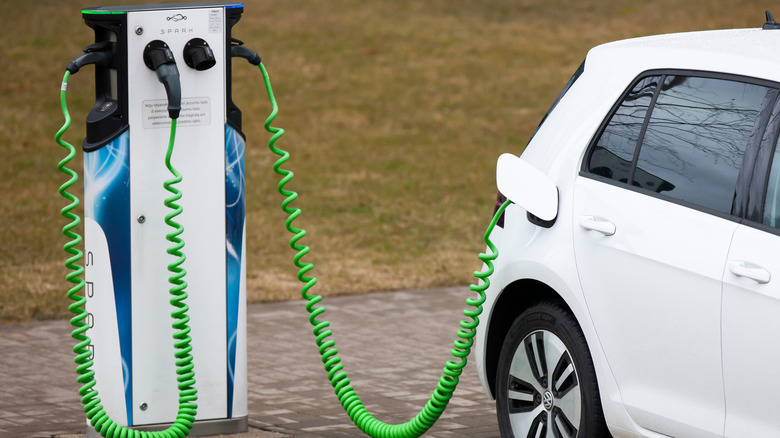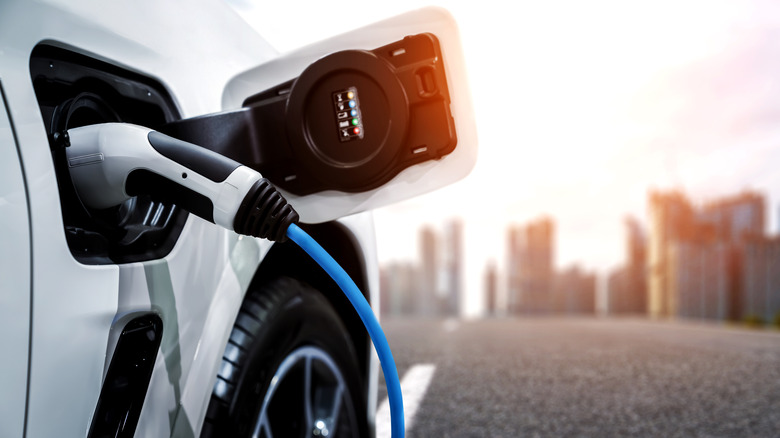

Replacing The Battery Pack On A VW E-Golf Costs More Than You Think
source link: https://www.slashgear.com/907923/replacing-the-battery-pack-on-a-vw-e-golf-costs-more-than-you-think/
Go to the source link to view the article. You can view the picture content, updated content and better typesetting reading experience. If the link is broken, please click the button below to view the snapshot at that time.

Replacing The Battery Pack On A VW E-Golf Costs More Than You Think

The ownership of any vehicle brings with it certain financial obligations; one of the most expensive and intrusive is vehicle maintenance. Regardless of how old or new a car is, it will sooner or later have mechanical issues. When it comes to electric vehicles like the VW e-Golf, one question many interested buyers have is how much replacing the battery on this electric vehicle will cost.
Consumers often worry about the price of EV battery replacements because they know that these batteries are much bigger and more complex than the ones used in internal combustion cars. Unfortunately, the size and level of complexity lead to higher price tags when it's time to get the battery serviced (via Bloomberg). Despite that, as automotive technology continues to improve, more people are diving into the world of electric vehicle ownership. If you've purchased or you're thinking about buying a VW e-Golf EV, you should know that replacing its battery may come with an unexpectedly huge price tag.
Cost to replace the battery

We know that with the continued use of any car battery, the cells will go through a degradation process. What complicates matters is that each vehicle type has different expectations for how long a battery will last. Potential VW e-Golf buyers should also be aware that although there is an average lifespan for their car's battery, there are outliers as some may have issues earlier than expected. Still, other vehicles may even outlive the promised expectancy.
The cost of replacing the battery in your VW e-Golf is more than you would think. As of 2021, this service on either a 2017 or a 2018 model cost up to an astounding $23,442.91, according to Recurrent Auto. Volkswagen e-Golf owners who are experiencing battery issues should check their car's warranty before paying for repairs because battery replacement may be covered if it happens within eight years of purchase. Though the price is steep, a full-on replacement isn't the only option. You can service the battery pack using either battery reconditioning or having only the faulty battery cells replaced (via Consumer Reports). Both are viable options, though you may find yourself in a situation where a full battery replacement is necessary.
There are a few steps VW e-Golf owners can take to help preserve their EV's battery. First, avoid extremes, which include allowing the battery's charge level to fall too low and overcharging it. Also, it's best to only use fast chargers when you have to, according to Inside EVs. If you're planning to buy a used VW e-Golf car, however, keep in mind that you won't know how the previous owner handled charging and whether they took battery health into consideration.
The good news

While the cost of replacing the battery in your VW e-Golf may surpass your expectations, there is still some good news for both potential buyers and current owners. Although it doesn't always happen, most EV batteries will outlast the vehicles they power, according to research from GeoTab. As well, it's uncommon for EV batteries to prematurely malfunction, and such instances should be covered by the vehicle's warranty, meaning the repair won't cost you anything.
The other good news involves the costs of the battery packs used to power electric cars like the VW e-Golf — the prices are declining across the board, which means the cost of buying an electric vehicle will decrease in time, putting EVs within the means of more consumers (via Car and Driver). This change is significant because although the e-Golf is no longer in production, both current owners and people who may potentially buy the car used will have a lower cost associated with replacing their battery packs.
EV Charging Explained: The Fastest Chargers At Home And On The Road

If your main concern with buying an electric car is figuring out how you're going to charge it, worry no more. There are plenty of different options – from the cable that comes bundled with all new EVs, through to super-fast public charging networks – and it's easy to get overwhelmed by the tech and the terminology. Read on to get up to speed on Level 1 and Level 2 chargers, DC fast charging, and where Tesla Superchargers fit in – and what to look out for when you need to add miles of range, fast.
Level 1 chargers are slowest but easiest to plug-in
If you've got a regular, 120V household outlet, you can use a Level 1 charger. Outfitted with the same plug as you'd find on a blender or a vacuum cleaner, their strength is in their ubiquity. Drive your EV to a friend's place and, even if they don't have an electric vehicle themselves, you should be able to find a place to plug in yours.
Every new EV you buy in the US today comes with a charger that will work, at the very least, with a 120V outlet. Often called a "mobile charger" or "travel charger" they're usually stored under the trunk floor or in the front trunk (or "frunk" in EV parlance) and designed to be an option-of-last-resort should you find yourself needing an emergency top-up somewhere.
The downside, as you might have guessed, is charging speed. Level 1 chargers are often known as "trickle chargers" because they deliver power so slowly. Figure on about 3 miles of range added per hour plugged in.
Level 2 chargers are what every EV owner needs
Assuming you have somewhere you can consistently park your EV, getting a Level 2 charger is a no-brainer for an electric vehicle driver as it's considerably faster than Level 1 chargers will ever be. For a Level 2 charger, you'll need a 240V outlet or – if your charger is permanently installed – a 240V connection from your circuit breaker box. The most common is a NEMA 6-50 outlet; expect to spend $200-300 on getting an electrician to install one, unless more significant upgrades to your wiring are required.
In return, you'll get much faster charging. Think along the lines of around 20-30 miles per charging hour, though there are a few factors which control that. Biggest is amperage: that can range from 12A to 50A, and many Level 2 chargers will allow you to adjust their settings depending on how what power is coming to the outlet. More amperage means faster charging, typically up to 7.6 kW.
Increasingly often, the travel charger included with new EVs supports both Level 1 and Level 2 use, with the right adapter. On the flip side, not every electrified vehicle supports 7.6 kW charging: some, particularly plug-in hybrids, top out at around half that. Still, if you're having a 240V outlet installed and buying a Level 2 charger, it's worth getting the most potent one you can for future-proofing purposes. Figure on $500-800 for a Level 2 charger with decent amperage headroom.
Level 3 DC fast chargers are worth looking out for
DC fast chargers, known as Level 3 chargers, are your gateway to the fastest recharge. They can deliver up to 350 kW – though 50-150 kW seems more common at the moment – if your EV supports it. That means a far more rapid charge, along the lines of 60-120 miles in about 10-20 minutes depending on the charger and the vehicle.
You can't install a Level 3 charger at home. Instead, they're operated by private networks like Electrify America, EVgo, ChargePoint, and others. Usually they're located near highways or other well-frequented routes.
Commonly they have a CCS plug, which most new EVs are fitted with. Sometimes it's an option, but it's one worth selecting if you ever plan to do road trips. Less common, but still offered on models like the Nissan Leaf, is the CHAdeMO plug. Often there'll be a mixture of both connectors at the same location, and multiple DC fast chargers on-site.
Typically, you'll need an account with each charger network in order to begin a charging session. Less common is the ability to pay at the charger, just like you would at a gas pump. Most have apps which help hunt down a location as well as authenticate the payment; some networks have roaming agreements, so that you can use multiple companies' chargers with just one account, and it's more common now for automakers to have similar agreements so that all the locations their EVs can use are collated in the dashboard navigation system.
The big factor controlling how fast you can recharge at a DC fast charger is the kW (kilowatt) rating. Each charger can deliver a certain maximum in kW: more, a higher number means a faster recharge. However, each electric vehicle can support a certain maximum in kW too. The two automatically adjust to deliver the maximum rate possible, but it's definitely worth checking the spec sheets as you research a new EV purchase: the difference in charging speed between, say, a 50 kW-capable EV and a 350 kW-capable EV is huge.
The Tesla Supercharger network is an electric privilege
If you're driving a Tesla, things are somewhat different from the rest of the EV field. Tesla not only makes its own electric cars, it's also building out a charging network – both in the US and abroad – at which those cars can charge up while away from home or the office.
There are actually two main types of Supercharger. The most familiar is a fast charger, capable of adding up to 200 miles of range in 15 minutes. That rate, as with any fast charger, can vary according to the model of Tesla, the specific charger, and conditions like the current battery level.
Tesla Destination Charging, meanwhile, is effectively Level 2 chargers with the Tesla-specific plug. Whereas Superchargers tend to be positioned near highways and other major routes, Destination Charging units are often found outside businesses, at hotels and convention centers, and similar. That makes them more accessible but, of course, you're getting a much slower rate of charge.
In the early days, Tesla buyers got free Supercharger access. At this point, that's a rare perk: far more common is paying for access, which varies by location. In some states, you pay depending on how long you're plugged in; in others, you pay based on how much charging you actually do. Either way, like with most EV chargers it's cheaper to "refuel" than an equivalent gas car.
Non-Tesla cars can't use Superchargers
One of the most common questions among new or potential EV owners is whether they can plug their electric car into a Supercharger. Unfortunately, only Tesla vehicles can use those chargers. Not only is the plug unique to Tesla, the vehicles rely upon an authentication system to authorize the charging session and process the payment.
Tesla offers adapters, meanwhile, so that its EVs can be used with non-Supercharger stations. These basically slot in-between the charging plug and the Tesla car, so that a Model 3 driver could recharge at, say, an Electrify America location. As you research a new electric vehicle, it's worth looking at maps of nearby chargers such as PlugShare, to figure out what options are near to where you might typically be driving.
If you're looking at buying a new electric vehicle, and need to install a new charger, there are rebates and incentives you may not know about which could help offset the cost. Check out our top tips for new EV buyers for more details.
Recommend
About Joyk
Aggregate valuable and interesting links.
Joyk means Joy of geeK